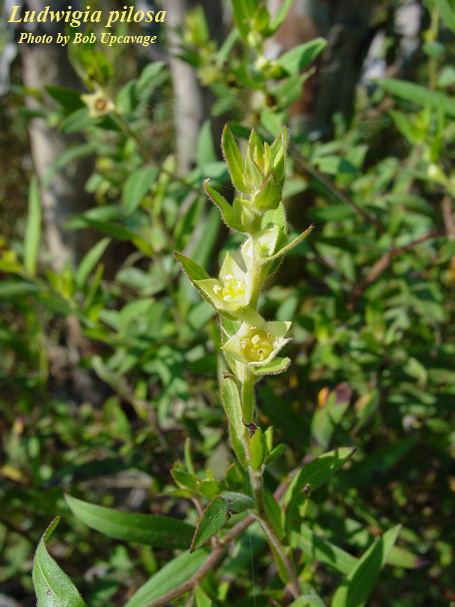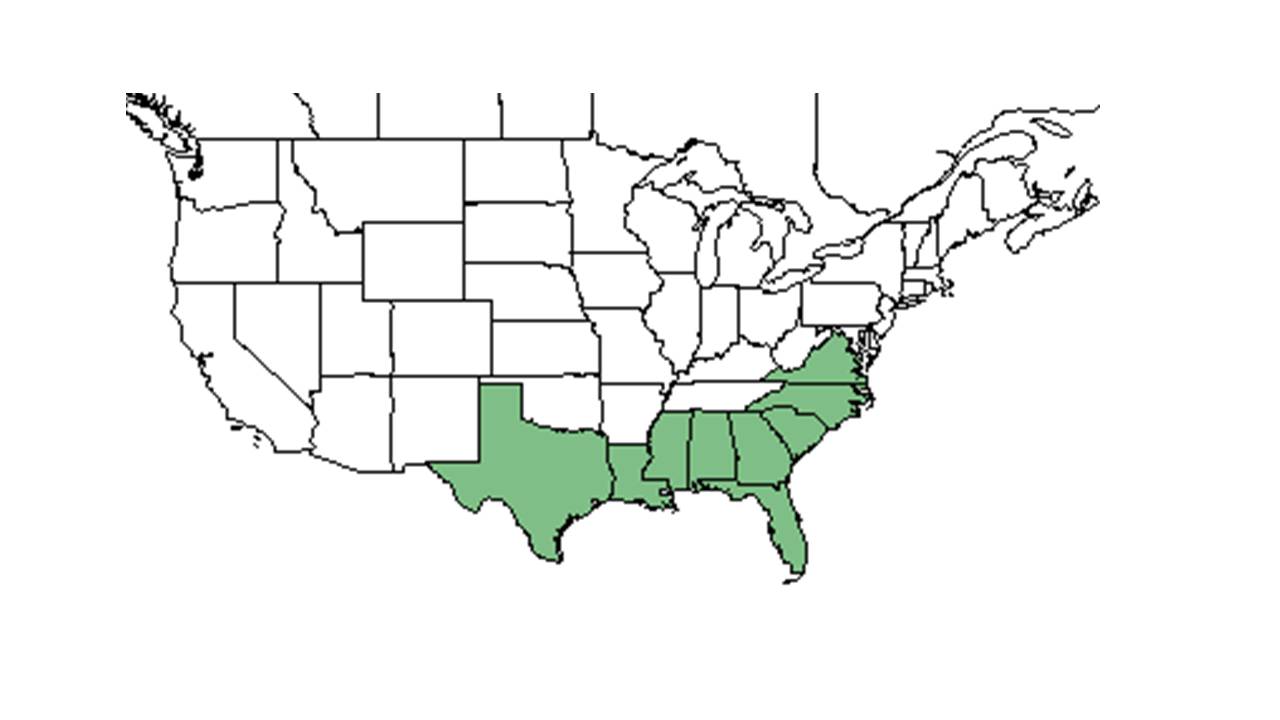Difference between revisions of "Ludwigia pilosa"
(→Ecology) |
(→Distribution) |
||
| (3 intermediate revisions by 2 users not shown) | |||
| Line 18: | Line 18: | ||
}} | }} | ||
| − | Common name: | + | Common name: hairy seedbox<ref name=weakley>Weakley, A.S. 2020. Flora of the Southeastern United States. Edition of 20 October 2020. University of North Carolina at Chapel Hill, Chapel Hill, North Carolina.</ref> |
==Taxonomic notes== | ==Taxonomic notes== | ||
| − | Synonyms: none | + | Synonyms: none<ref name=weakley/> |
| + | |||
| + | Varieties: none<ref name=weakley/> | ||
| − | |||
==Description== | ==Description== | ||
<!-- Basic life history facts such as annual/perrenial, monoecious/dioecious, root morphology, seed type, etc. --> | <!-- Basic life history facts such as annual/perrenial, monoecious/dioecious, root morphology, seed type, etc. --> | ||
| Line 30: | Line 31: | ||
==Distribution== | ==Distribution== | ||
| − | ''L. pilosa'' ranges from southeastern Virginia to north Florida and west to southeastern Texas. It is restricted to the Coastal Plain with disjunct populations in North Carolina, Virginia, and northern Alabama.<ref name= | + | ''L. pilosa'' ranges from southeastern Virginia to north Florida and west to southeastern Texas. It is restricted to the Coastal Plain with disjunct populations in North Carolina, Virginia, and northern Alabama.<ref name=weakley/> |
| + | |||
==Ecology== | ==Ecology== | ||
===Habitat=== <!--Natural communities, human disturbed habitats, topography, hydrology, soils, light, fire regime requirements for removal of competition, etc.--> | ===Habitat=== <!--Natural communities, human disturbed habitats, topography, hydrology, soils, light, fire regime requirements for removal of competition, etc.--> | ||
This species can be found in marshes, open meadows, seepages, cypress-gum ponds, bogs, open pinewood lands, as well as edges of hammocks in wet, peaty, loamy sand and mud.<ref name="FSU Herbarium">Florida State University Robert K. Godfrey Herbarium database. URL: [http://herbarium.bio.fsu.edu http://herbarium.bio.fsu.edu]. Last accessed: June 2014. Collectors: P. Adams, Loran C. Anderson, Robert K. Godfrey, Almut G. Jones, R. Kral, Robert L. Lazor, Sidney McDaniel, Marc Minno, Neal Morar, T. Myint, R. A. Norris, R. E. Perdue, Jr., Cecil R Slaughter, R. R. Smith, and Jean W. Wooten. States and Counties: Bay, Calhoun, Clay, Columbia, Duval, Escambia, Franklin, Gadsden, Gulf, Holmes, Jefferson, Leon, Liberty, Nassau, Okaloosa, Polk, Santa Rosa, Wakulla, Walton, and Washington. Georgia: Grady.</ref> It also has been observed in human disturbed areas such as lawns, ditches, clear cut pinewoods, along roadsides, edges of pine plantations, along canals, and near parking areas.<ref name="FSU Herbarium"/> Associated species include ''Ludwigia sphaerocarpa, Cypress, Liquidambar styraciflua, Magnolia, Nyssa, Pinchkneya, Quercus, Ludwigia linearis, Ludwigia octovalvis, Carex, Juncus, Cyperus, Sagittaria, Lythrym, Boltonia, Helianthus, Taxodium, Acer, Pinus elliottii, Ludwigia microcarpa, Lycopus, Ludwigia hirtella,'' and ''Ludwigia balata''.<ref name="FSU Herbarium"/> | This species can be found in marshes, open meadows, seepages, cypress-gum ponds, bogs, open pinewood lands, as well as edges of hammocks in wet, peaty, loamy sand and mud.<ref name="FSU Herbarium">Florida State University Robert K. Godfrey Herbarium database. URL: [http://herbarium.bio.fsu.edu http://herbarium.bio.fsu.edu]. Last accessed: June 2014. Collectors: P. Adams, Loran C. Anderson, Robert K. Godfrey, Almut G. Jones, R. Kral, Robert L. Lazor, Sidney McDaniel, Marc Minno, Neal Morar, T. Myint, R. A. Norris, R. E. Perdue, Jr., Cecil R Slaughter, R. R. Smith, and Jean W. Wooten. States and Counties: Bay, Calhoun, Clay, Columbia, Duval, Escambia, Franklin, Gadsden, Gulf, Holmes, Jefferson, Leon, Liberty, Nassau, Okaloosa, Polk, Santa Rosa, Wakulla, Walton, and Washington. Georgia: Grady.</ref> It also has been observed in human disturbed areas such as lawns, ditches, clear cut pinewoods, along roadsides, edges of pine plantations, along canals, and near parking areas.<ref name="FSU Herbarium"/> Associated species include ''Ludwigia sphaerocarpa, Cypress, Liquidambar styraciflua, Magnolia, Nyssa, Pinchkneya, Quercus, Ludwigia linearis, Ludwigia octovalvis, Carex, Juncus, Cyperus, Sagittaria, Lythrym, Boltonia, Helianthus, Taxodium, Acer, Pinus elliottii, Ludwigia microcarpa, Lycopus, Ludwigia hirtella,'' and ''Ludwigia balata''.<ref name="FSU Herbarium"/> | ||
| − | |||
===Phenology=== <!--Timing off flowering, fruiting, seed dispersal, and environmental triggers. Cite PanFlora website if appropriate: http://www.gilnelson.com/PanFlora/ --> | ===Phenology=== <!--Timing off flowering, fruiting, seed dispersal, and environmental triggers. Cite PanFlora website if appropriate: http://www.gilnelson.com/PanFlora/ --> | ||
''L. pilosa'' has been observed to flower in May and from July through October and fruit from July through November.<ref name="FSU Herbarium"/><ref>Nelson, G. [http://www.gilnelson.com/ PanFlora]: Plant data for the eastern United States with emphasis on the Southeastern Coastal Plains, Florida, and the Florida Panhandle. www.gilnelson.com/PanFlora/ Accessed: 12 DEC 2016</ref> | ''L. pilosa'' has been observed to flower in May and from July through October and fruit from July through November.<ref name="FSU Herbarium"/><ref>Nelson, G. [http://www.gilnelson.com/ PanFlora]: Plant data for the eastern United States with emphasis on the Southeastern Coastal Plains, Florida, and the Florida Panhandle. www.gilnelson.com/PanFlora/ Accessed: 12 DEC 2016</ref> | ||
| Line 41: | Line 42: | ||
<!--===Seed bank and germination===--> | <!--===Seed bank and germination===--> | ||
<!--===Fire ecology===--> <!--Fire tolerance, fire dependence, adaptive fire responses--> | <!--===Fire ecology===--> <!--Fire tolerance, fire dependence, adaptive fire responses--> | ||
| − | <!--===Pollination and | + | <!--===Pollination===--> |
| + | <!--===Herbivory and toxicology===--> | ||
<!--===Diseases and parasites===--> | <!--===Diseases and parasites===--> | ||
Latest revision as of 14:15, 15 June 2023
| Ludwigia pilosa | |
|---|---|

| |
| Photo by Bob Upcavage, Atlas of Florida Vascular Plants | |
| Scientific classification | |
| Kingdom: | Plantae |
| Division: | Magnoliophyta - Flowering plants |
| Class: | Magnoliopsida – Dicotyledons |
| Order: | Myrtales |
| Family: | Onagraceae |
| Genus: | Ludwigia |
| Species: | L. pilosa |
| Binomial name | |
| Ludwigia pilosa Walter | |

| |
| Natural range of Ludwigia pilosa from USDA NRCS Plants Database. | |
Common name: hairy seedbox[1]
Contents
Taxonomic notes
Synonyms: none[1]
Varieties: none[1]
Description
“Repent or erect, usually branched, short-lived perennials, or rarely annual. Floral parts in 4-7’s; hypanthium not prolonged beyond ovary. Capsules longitudinally or poricidally multiseriate, rarely uniseriate. Most of the erect species produce basal offshoots, which have ovate to obovate leaves, in the late summer and fall. Bracteoles occur in pairs on the pedicel or stipe or on the base of the hypanthium.”[2]
"Stems erect, branched, densely pubescent, to 9 m tall. Leaves alternate, elliptic to lanceolate, pubescent, to 7.5 cm long and 13 mm wide; petioles absent or rarely to 2 mm long. Sepals 4, deltoid-ovate, ca. 4 mm long; petals usually absent. Capsules subglobose, pubescent, 3-3.8 mm long and broad; bracteoles linear, 2.5-4.2 mm long; pedicels absent or less than 1 mm long."[2]
Distribution
L. pilosa ranges from southeastern Virginia to north Florida and west to southeastern Texas. It is restricted to the Coastal Plain with disjunct populations in North Carolina, Virginia, and northern Alabama.[1]
Ecology
Habitat
This species can be found in marshes, open meadows, seepages, cypress-gum ponds, bogs, open pinewood lands, as well as edges of hammocks in wet, peaty, loamy sand and mud.[3] It also has been observed in human disturbed areas such as lawns, ditches, clear cut pinewoods, along roadsides, edges of pine plantations, along canals, and near parking areas.[3] Associated species include Ludwigia sphaerocarpa, Cypress, Liquidambar styraciflua, Magnolia, Nyssa, Pinchkneya, Quercus, Ludwigia linearis, Ludwigia octovalvis, Carex, Juncus, Cyperus, Sagittaria, Lythrym, Boltonia, Helianthus, Taxodium, Acer, Pinus elliottii, Ludwigia microcarpa, Lycopus, Ludwigia hirtella, and Ludwigia balata.[3]
Phenology
L. pilosa has been observed to flower in May and from July through October and fruit from July through November.[3][4]
Conservation, cultivation, and restoration
Cultural use
Photo Gallery
References and notes
- ↑ 1.0 1.1 1.2 1.3 Weakley, A.S. 2020. Flora of the Southeastern United States. Edition of 20 October 2020. University of North Carolina at Chapel Hill, Chapel Hill, North Carolina.
- ↑ 2.0 2.1 Radford, Albert E., Harry E. Ahles, and C. Ritchie Bell. Manual of the Vascular Flora of the Carolinas. 1964, 1968. The University of North Carolina Press. 744-7. Print.
- ↑ 3.0 3.1 3.2 3.3 Florida State University Robert K. Godfrey Herbarium database. URL: http://herbarium.bio.fsu.edu. Last accessed: June 2014. Collectors: P. Adams, Loran C. Anderson, Robert K. Godfrey, Almut G. Jones, R. Kral, Robert L. Lazor, Sidney McDaniel, Marc Minno, Neal Morar, T. Myint, R. A. Norris, R. E. Perdue, Jr., Cecil R Slaughter, R. R. Smith, and Jean W. Wooten. States and Counties: Bay, Calhoun, Clay, Columbia, Duval, Escambia, Franklin, Gadsden, Gulf, Holmes, Jefferson, Leon, Liberty, Nassau, Okaloosa, Polk, Santa Rosa, Wakulla, Walton, and Washington. Georgia: Grady.
- ↑ Nelson, G. PanFlora: Plant data for the eastern United States with emphasis on the Southeastern Coastal Plains, Florida, and the Florida Panhandle. www.gilnelson.com/PanFlora/ Accessed: 12 DEC 2016